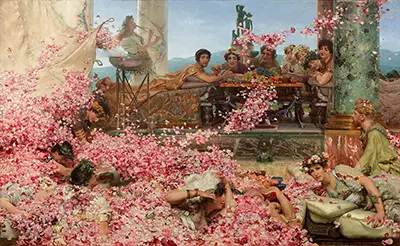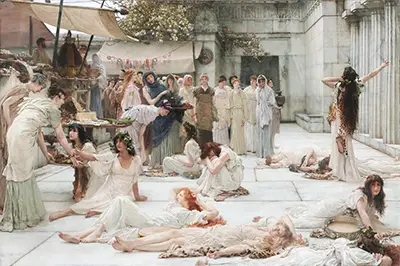Technically brilliant and with a keen eye for detail, Lawrence Alma-Tadema was one of the best known artists during the Victorian period.
Alma-Tadema produced many decorative paintings of classical and romantic scenes which were highly popular during his lifetime. From early on in his career Alma-Tadema showed promise, receiving accolades and prizes for his work even during his studies. Although he was originally expected to enter law professionally, Alma-Tadema suffered a physical and mental breakdown aged 15. As a result he was allowed to choose his own path and instead decided to become an artist.
To this end he learnt under Egide Charles Gustave Wappers at the Royal Academy of Antwerp (his family was at that time settled in Belgium) where he studied Flemish and Dutch art. Alma-Tadema went on to be a studio assistant to Louis Jan de Taeye between 1855-1858. De Taeye was fascinated by historical costumes and history and these caught the imagination of Alma-Tadema. De Taeyes was also a strong proponent of historical accuracy and Alma-Tadema was encouraged to depict this in his own works. This attention to detail in producing ancient scenes went on to become one of the traits of his work.
One of the most highly regarded studios of the time in Belgium at the time was that of Jan August Hendrik Leys, and Alma-Tadema's next post was here. Leys was an exacting master, critical of Alma-Tadema's treatment of cheese. Alma-Tadema took the criticism seriously, using it to improve and refine his work- subsequently he has become especially noted for his ability to bring hard metals and stone surfaces like marble eloquently to life. With the help of Leys Alma-Tadema produced his first major work 'The Education of the Children of Clovis' (1861). The piece was well received by critics and the public, eventually being presented to King Leopold of Belgium.
1863 marked a turning point for Alma-Tadema. His early studies had fired his passion for the ancient world (albeit it mainly from Merovingian subjects) whilst he had learned to pay attention to detail in terms of detailing and historically accurate styling. However his marriage in September 1863 and the honeymoon that followed touring through Italy changed the direction of his inspiration. He and his new wife (Marie-Pauline Gressin Dumoulin) toured extensively, but their time amongst the ruins of Pompeii fascinated him. The veins of inspiration here proved the muse for much of the work throughout his lifetime.
Sadly Marie-Pauline died in 1869 of small pox, throwing Alma-Tadema into a depression that stopped him painting for several months. He himself was suffering from an undiagnosed illness, and he was recommended to visit England to seek further medical advice. First visiting London in 1869 but then returning in 1870 after the outbreak of the Franco-Prussian war, Alma-Tadema got to know many of the Pre-Raphaelite artists. He met his second wife, Laura Epps, at the house of Ford Madox Ford and was well acquainted with the work and style of the Pre-Raphaelites.
The Pre-Raphaelite desire to show the world naturally and to bring to life precisely all the details they saw fitted naturally with Alma-Tadema's ethos. Although he has been named as a pre-Raphaelite artist, his work has always remained slightly outside of their style and subject area. Pre-Raphaelite works tend to be meaningful as well as decorative. However their effect upon him was to lighten his palette. This set the basis for Alma-Tadema's work. His reputation as a painter of detailed and nostalgic classical scenes was set.






























